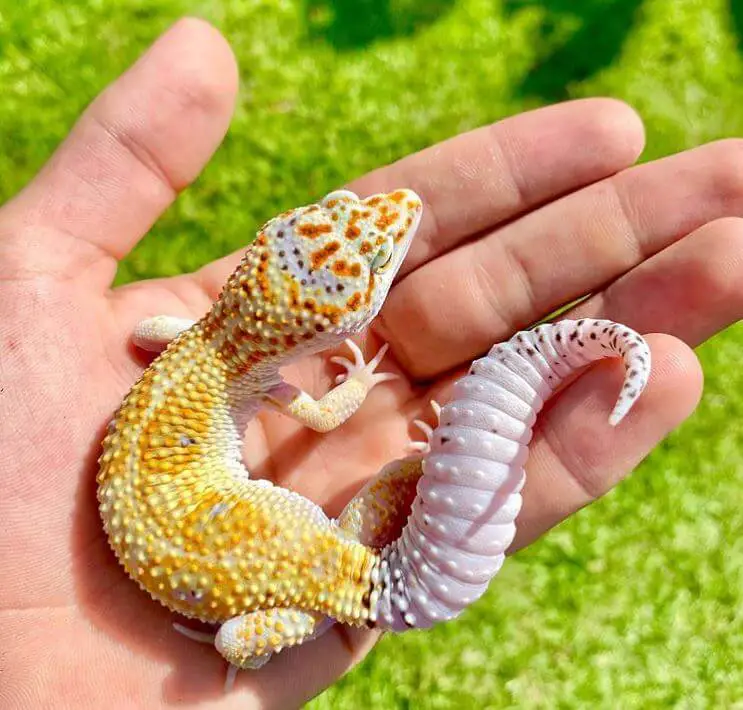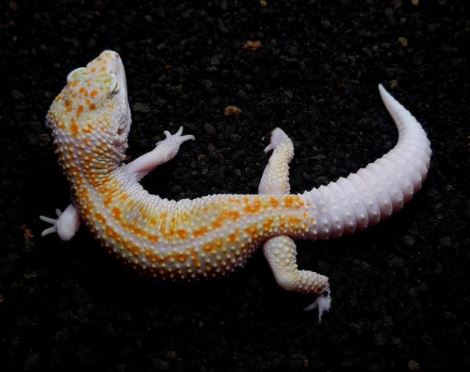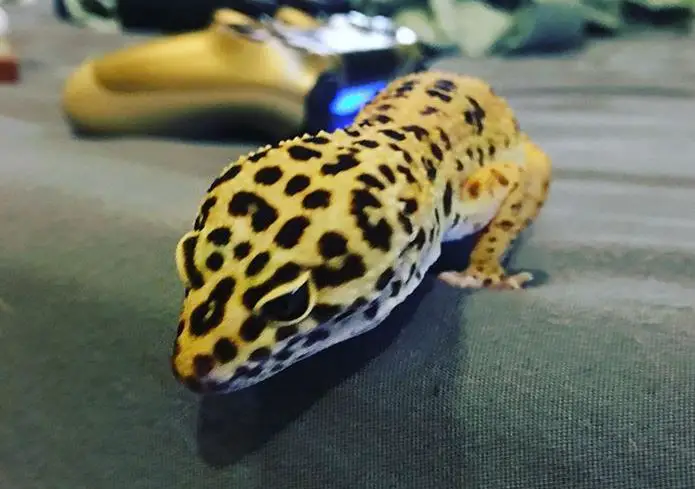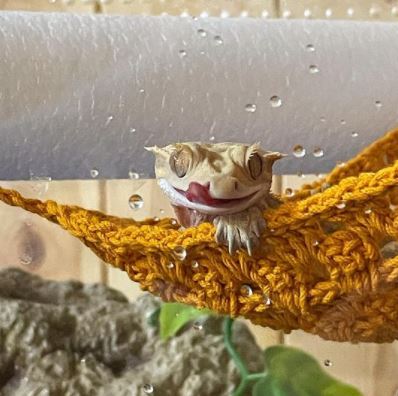Do leopard geckos need heat lamp at night?
One of the many things that you need to know about owning a leopard gecko is whether or not they need heat lamps at night. There are different opinions on this topic and it’s important for any new owner to understand both sides.
Related Posts:
- Top 7 Best Leopard Gecko Starter Kits for Easy Setup
- What Tank Size Does a Leopard Gecko Need?
- How Often Should You Mist a Leopard Gecko Tank?
- How Deep Should Leopard Gecko Substrate Be?
- Why Is My Leopard Gecko Hiding and Not Eating?
Do Leopard Geckos Need a Heat Lamp at Night?
Do leopard geckos need a heat lamp at night?
Yes, leopard geckos use their environment to keep their body temperature steady. One end of the tank needs a heat lamp and the other end needs to be cooler.
At night, turn off the heat lamp but make sure that it does not get below 18 degrees Celsius.
During the day, leopard geckos need a temperature of 30 degrees C.
Leopard geckos need to have a minimum of 5 hours at this temperature throughout the day.
If you find that your leopard gecko is constantly hiding underneath its rock, then it is probably too cold and needs more basking time, so turn up the lamp or turn the heating pad on for an hour or so.
A heat lamp can be used at night to provide some warmth (if they don’t already have it) but they should not need it in most cases.
The size of the tank and how much you are able to cover with bedding is important in providing insulation. But generally, they will be fine without it.
If your leopard gecko’s belly is not plump and full, then they probably need more food or warmer temperatures at night, or both.
I do recommend using a heat lamp for heating the tank at night, especially if you get into colder seasons of the year.
Mine stays on even when we get chilly nights in Florida. But when it is chilly, I turn the lamp on during waking hours to give the tank a chance to warm up.

In general, leopard geckos do not need a heat lamp at night. But for many people, this is a way to keep their tank at a stable temperature by using it.
If they do not need heat, the gecko may get too cold and this will increase their chances of health issues such as respiratory infections or other problems.
If you are going to use a heat lamp, I recommend adding another light source such as a red bulb to reduce the amount of stress it puts on them.
I do not recommend using a heat lamp at night without another light source, but this is just my personal opinion and you should use what you feel comfortable with.
As for the thermometer, if you are using a heat lamp, I highly recommend using both an under-tank heater and a heat mat to provide the basking area with heat.
If this is not enough, then you can try adding an additional lamp but be sure that your leopard gecko has a place to go and hide if it gets too hot (such as a hiding spot under the basking rock).
If you find your leopard gecko is constantly in its hiding spot during waking hours, then turn down the heat lamps.
Do Leopard Geckos Need LED Lighting?
I have yet to come across a leopard gecko that is being kept under LED lights.
The UVB rays are what they need most for calcium absorption and they cannot get this from the light itself, so the only time you would want to use an LED is if it came with a UVB strip light included.
If your gecko is not basking under a heat lamp, then it does not need the additional UVB.

Are Rainbow LED Lights Bad for Leopard Geckos?
No, rainbow LEDs are not bad for your leopard gecko. They may be a little harder on the wallet but they do provide beneficial light for nocturnal viewing and make their enclosure more interesting.
We use our rainbow LED lights at night when we aren’t looking in on them to reduce stress from bright flashes of light coming in through a window or disrupting their sleep.
It is best to use a heat lamp at night with another light source such as a red bulb for heat and warmth.
If you do not need the heat, then it is best not to use a heat lamp but you can try using an additional light source if your leopard gecko gets cold at night.
Leopard geckos are nocturnal and do not require additional UVB light during the night.
Nighttime viewing with rainbow LED lights is an option for those willing to invest in them, but it does not provide any health benefit or essential light (UVB) for calcium absorption like a heat lamp would.
A red bulb should also be used as a night light if you are going to use any lighting at all.
In the wild, they hunt and hide from predators during the day, so your leopard gecko should be sleeping during this time of day unless they have been slowly introduced to new lights as some breeders recommend for younger geckos.
Try to mimic their natural habitat as best you can to keep them happy and healthy.

How Many Watts Do Leopard Gecko Heat Lamps Use?
A 50/100-watt heat lamp bulb is often used for nighttime heat. A 40-watt red night light can be placed over one corner of the tank for night viewing.
A 100-watt heat bulb is commonly used for daytime basking at low temperatures, especially in colder areas to prevent the gecko from getting too cold.
There are also ceramic heat emitters that can be used to provide heat. Wattages for heat lamps usually range from 40 watts to 150 watts.
Conclusion
Do leopard geckos need a heat lamp at night?
Yes, leopard geckos do need a heat lamp at night. Depending on the species of leopard gecko you own will determine what type of bulb to use.
The most popular choice is an incandescent light because it mimics daylight and doesn’t produce much in the way of UV radiation, which can cause eye problems for your pet.
It also provides enough warmth without being too hot or cold, which could be harmful to them if they are not accustomed to it.
Finally, this type of lighting system produces very low levels of electromagnetic waves that can interfere with their natural cycles.
Key points on whether leopard geckos need heat lamps at night:
Leopard geckos, popular as pets for their charming appearance and low maintenance, have specific heating requirements for their well-being. One common question is whether leopard geckos need heat lamps at night. Understanding their heating needs is essential for providing proper care. Here are some key points to consider:
1. Nocturnal Nature:
- Leopard geckos are primarily nocturnal, meaning they are most active during the night.
- They have evolved to thrive in low-light conditions.
2. Temperature Gradient:
- Leopard geckos require a temperature gradient in their enclosure, which means they need access to both warm and cooler areas.
- A basking area with a heat source is essential for maintaining the warmer end of the gradient.
3. Absence of Light Emitting Heat:
- While leopard geckos benefit from a basking spot with a heat source during the day, they do not need light-emitting heat lamps at night.
- Providing 24-hour lighting can disrupt their natural circadian rhythm.
4. Dark Period:
- Leopard geckos need a period of darkness at night to rest, simulate their natural environment, and maintain a healthy circadian cycle.
- Darkness is crucial for their well-being.
5. Supplementary Heat Sources:
- Instead of light-emitting heat lamps, consider alternative heat sources for nighttime.
- Under-tank heating mats or ceramic heat emitters (CHEs) can provide the necessary warmth without emitting visible light.
6. Heating Mats:
- Under-tank heating mats are placed beneath the enclosure to warm the substrate.
- These mats create a gentle, radiant heat from below, providing the gecko with a warm surface to rest on.
7. Ceramic Heat Emitters (CHEs):
- CHEs are non-light-emitting heat sources that screw into a ceramic socket.
- They emit infrared heat, effectively raising the temperature in the enclosure without disturbing the gecko’s sleep.
8. Temperature Control:
- Always use a thermostat or temperature controller with heating equipment to maintain a stable and safe temperature.
- Leopard geckos are sensitive to temperature fluctuations.
9. Proper Basking Area:
- During the day, provide a basking area with a heat source to achieve the optimal temperature range (usually around 90°F or 32°C) for digestion and thermoregulation.
10. Monitoring Temperature:
- Regularly monitor the temperatures in the enclosure to ensure they align with the gecko’s needs.
- Use a digital thermometer with probes to measure the temperatures accurately.
11. Optimal Night Temperatures:
- Leopard geckos thrive at slightly cooler nighttime temperatures, typically ranging between 70-75°F (21-24°C).
In summary, leopard geckos do not require light-emitting heat lamps at night. Providing a period of darkness is crucial for their well-being and natural behaviors. Instead, consider alternative heat sources like under-tank heating mats or ceramic heat emitters to maintain the necessary temperatures while allowing your gecko to experience a natural day-night cycle. Proper temperature control and monitoring are essential for ensuring the health and comfort of your pet leopard gecko.


